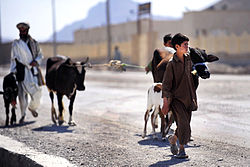Farah, Afghanistan
|
Farah فراه |
|
|---|---|
| City | |
 |
|
| Location in Afghanistan | |
| Coordinates: 32°20′37″N 62°7′10″E / 32.34361°N 62.11944°ECoordinates: 32°20′37″N 62°7′10″E / 32.34361°N 62.11944°E | |
| Country |
|
| Province | Farah Province |
| Government | |
| • Mayor | Abdul Rahim Ishaqzai |
| Elevation | 2,297 ft (650 m) |
| Population (2012) | |
| • City | 540,000 |
| • Urban | 54,000 |
| Time zone | UTC+4:30 |
Farah (Pashto / Dari Persian: فراه) is the capital of Farah Province, located in western Afghanistan. It is about the 16th-largest city of the country in terms of population. The Farah Airport is located in the area.
Farah is located in western Afghanistan, close to Herat and Iran, although it lacks a direct road connection with the latter. Farah has a very clear grid of roads distributed through the higher density residential areas. However barren land (35%) and vacant plots (25%) are the largest land uses and combine for 60% of total land use.
The Citadel at Farah is probably one of a series of fortresses constructed by Alexander the Great, the city being an intermediate stop between Herat, the location of another of Alexander's fortresses, and Kandahar. The ‘Alexandria’ prefix was added to the city’s name when Alexander came in 330 BC.
Under the Parthian Empire, Farah fell under the satrapy of Aria, and was one of its key cities. It is thought to be Phra, mentioned by Isidorus Characenus in the 1st century AD, or Alexandria Prophthasia mentioned by Pliny the Elder and the 4th century Peutinger Map.
In the 5th century CE Farah was one of the major strongholds on the eastern frontier of the Sassanid Empire.
The region was historically part of Khorasan province and was controlled by the Tahirids followed by the Saffarids, Samanids, Ghaznavids, Ghurids, Khwarazmshahs, Ilkhanates, Timurids, Khanate of Bukhara, and Saffavids until the early-18th century when it became part of the Afghan Hotaki dynasty followed by the Durrani Empire.
...
Wikipedia

